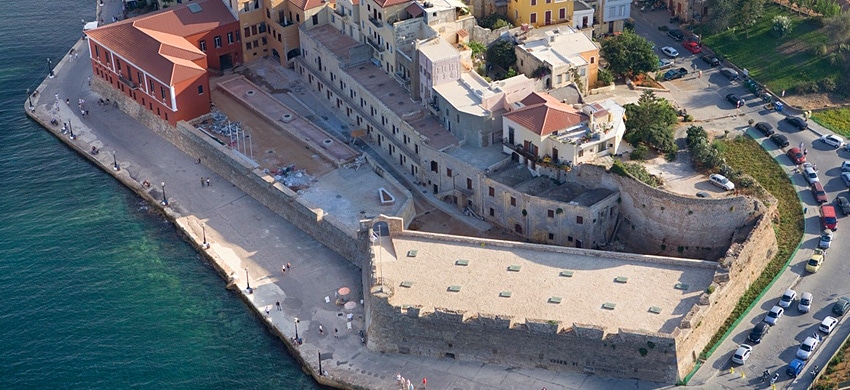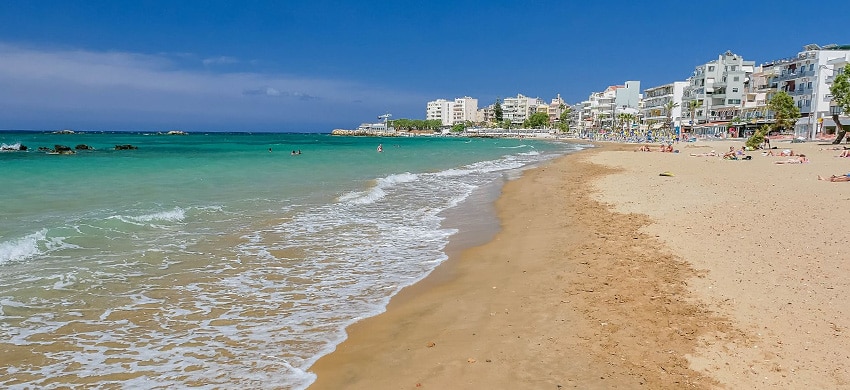

Nicknamed the Venice of the East, Chania (or La Canea) is a beautiful town located on the northern coast of the island of Crete. The city presents itself as one of the most popular destinations in this area thanks to its beaches, its historical center and its architectural heritage. Chania also played the role of capital of Crete, from 1847 to 1972, while today it is the second largest city of the island after Heraklion.
It is a very picturesque town which bears witness to the different civilizations that have followed one another here over the centuries. The city, in fact, after being an important center for the Minoan civilization has become first a Roman colony and, in later centuries, the domain of the Venetians, Genoese and finally of the Ottomans.
The old town is built around the port and is a well-preserved area where Venetian and Turkish buildings create a truly unique and original environment. A lively and multicultural city whose past can be seen walking through its alleys where churches and beautiful fountains coexist with mosques and beautiful Italian-style buildings.
Chania (also known as Haniá or La Canea) is a town that has developed around the port and now consists of its old town and new settlements. The oldest part is surrounded by walls of Byzantine origin that define its boundaries and that have protected and preserved it over the years. Chania is a city to visit during a trip to Crete because it will surely conquer you not only with its charm and its beaches but also with its culinary tradition.

The port of the city is a really characteristic and at the same time very sparkling area of this town. Its design was conceived by the Venetian engineer Michele Sammichelli, the same one who also designed the walls of the city of Heraklion. At the entrance of the port you can notice a picturesque and imposing lighthouse that was originally built by the Venetians and later renovated in the 19th century by the Egyptians.
Along the half-moon shaped dock there are several bars and restaurants with outdoor tables very popular with tourists thanks to the excellent view and the lively atmosphere.

Always at the port you can also find the beautiful Yali Tzamisi, the oldest mosque in Crete. The building dates back to the mid-seventeenth century when it was built on the foundations of an earlier church of Byzantine origin to pay homage to the governor of the city at the time.
Today it is known as the Mosque of the Janissaries a name given in homage to the Janissaries who are buried in the courtyard of the building. The mosque, consisting of a large main dome and seven smaller domes, is currently no longer a place of worship but a space that hosts exhibitions, events and temporary exhibitions.

Old Chania is the place to get lost in the alleys characterized by taverns, churches, artisans’ stores and small stores. Narrow streets surrounded by Venetian-style buildings where you can still see the coats of arms of the Venetian Republic on the doors of many houses.
The main square Eleftherios Venizelos, once known as Santrivani, was the place where students, philosophers and politicians gathered to debate and discuss. Now in the center of this square there is a beautiful white marble fountain while all around there are bars and taverns that make it one of the favorite meeting places for tourists.
The Archaeological Museum of Chania is located inside the ancient Venetian church of St. Francis (Aghios Fragkiskos) and houses exhibits ranging from the Neolithic period to the Roman era. Among the most famous findings is the Master Imp ression (the imprint of a very large signet ring) as well as a rich series of tablets and amphorae with inscriptions in Linear B.
The building has maintained its original architecture with three naves and a central stone vault, while in the floors there are wonderful mosaics of Byzantine origin.
One of the most picturesque areas of the city is certainly Tabakaria, the district where once there were the most famous tanneries of the city built between 1820 and 1830. These handicraft activities were active until the end of the 50s of the last century, when the arrival of technology left less and less room for the artisanal processing of leather
There are now a few workshops and stores left that sell leather goods and souvenirs while some former buildings have been converted into taverns or restaurants.

The Firkas Fortress currently houses the Naval Museum and a small open-air theater. The fortress is located in the district of Topanas, which at the time of Turkish rule was inhabited by the wealthiest families of the city. The museum houses exhibits that narrate the maritime traditions of Crete and Chania, through an extensive collection of nautical charts, ship models, naval instruments and other memorabilia.

The western side of Crete, where Chania is located, is home to some of the most beautiful beaches in Greece. Among the bathing areas closest to the city center, and therefore most frequented, we find Nea Chora Beach7, characterized by a long and sandy beach. It is a well equipped area with excellent accommodation facilities and taverns that offer excellent fresh fish.
In the prefecture of Chania, instead, we find excellent beaches in the north a few kilometers from the city, such as the areas Santi Apostoli and Santa Marina, but also more distant such as Maleme, Falasarna (famous for its beautiful sunsets) and Georgioypoli. Do not forget also Platanias and Agia Marina Beach, the perfect destinations for those who love beach clubs and parties that last from the afternoon until late at night
In the southern area, instead, there are the fascinating beaches of the Gulf of Elafonissi, characterized by pink sand and by the presence of a beautiful coral reef.
In the following map you can see the location of the main places of interest mentioned in this article.
Chania is certainly one of the most picturesque places to stay in Crete and from this location you can easily reach attractions such as the lagoon of Balos, the Gorges of Samaria and the beaches of Elafonissi. Since the city is a very popular destination in summer, we recommend that you book your stay in advance to find, at affordable prices, the most suitable structure for you
The city offers a wide choice in terms of accommodation including luxury hotels, studios (studios with bathroom and kitchenette), small bed and breakfast and apartments.
We offer a selection of hotels at Chania to suit all categories of travellers. The most booked by tourists are the sea-facing hotels, often right on the beach. If you want to play it safe, choose one of the following: they are among the most booked hotels in Chania, sorted by number of reviews.
If you prefer space, privacy and the ability to prepare your own meals to a hotel holiday, book a holiday home at Chania. We recommend a few below, but in this case we advise you to book early because houses and apartments for rent at Chania are in high demand.

The International Airport of Chania is located about 15 km east of the city center and is the second most important airport of the island after Heraklion. Especially during the summer season from several European airports you can reach Chania with a low-cost flight of a few hours.
Once in the airport you can choose to reach the center by bus (cheaper but slower solution), by cab (faster but more expensive solution) or by renting a car.
Alternative to the plane can be the ferry: the port is located in Souda, on the northwest coast of the island and has daily connections with the port of Piraeus. The journey by ferry can be long and tiring but at the same time it can give you the possibility to bring your car with you, thus avoiding having to rent one.
What's the weather at Chania? Below are the temperatures and the weather forecast at Chania for the next few days.
Chania is the capital city of the homonymous prefecture located on the Greek island of Crete. This locality is situated on the north-western coast of the island and is about 140 km from the city Heraklion, capital of Crete, and 200 km from Agios Nikolaos.